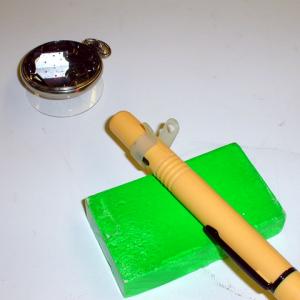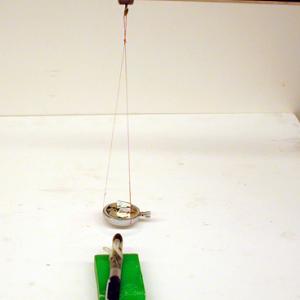College of Liberal Arts & Sciences
1Q40.50 - Action-Reaction Demo - Pocket Watch - Tail Wags the Dog
The pocket watch should have the mirror already attached at the appropriate point. Balance the watch on the watch glass so that it sits level. Shine the laser onto the mirror so that it reflects from a point nearest the center of the watch. The reflected laser spot should be directed at a screen across the lecture room. As the watch ticks, the movement of the balancing wheel will make the watch move in the opposite direction. This will be apparent as the laser spot will move up to 4 inches with each "tick".
The watch that can be hung by the strings will be more sensitive to movements than the one balanced on the watch glass. However, it also takes an appreciable amount of time to settle down if the table is moved or bumped.
- David Kagan, "Detecting the Hard Drive in an iPod", TPT, Vol. 43, # 8, Nov. 2005, p. 551.
- Jeffrey M. Wetherhold, "Modeling a Spacecraft's Malfunction", TPT, Vol. 37, #4, Apr. 1999, p. 196.
- Gerge Barnes, "Fun with a "Power" - Return Measuring Tape", TPT, Vol. 23, # 9, Dec. 1985, p. 551.
- R. W. Pohl, "(2)", Physical Principles of Mechanics and Acoustics, p. 258.
- Charles Vivian, "Watch Your Pulse Work", Science Experiments & Amusements For Children, p. 95.
- Martin Gardner, "Pulse Detector", Entertaining Science Experiments with Everyday Objects, p. 25.
- "A Mysterious Watch", The Boy Scientist, p. 226.
- Alistair Lightfoot, "Tap-L Discussions", 1/12/05.
- Julius Sumner Miller, Q161 & A161, Millergrams II – Some More Enchanting Questions for Enquiring Minds, p. 36 & 94.
Disclaimer: These demonstrations are provided only for illustrative use by persons affiliated with The University of Iowa and only under the direction of a trained instructor or physicist. The University of Iowa is not responsible for demonstrations performed by those using their own equipment or who choose to use this reference material for their own purpose. The demonstrations included here are within the public domain and can be found in materials contained in libraries, bookstores, and through electronic sources. Performing all or any portion of any of these demonstrations, with or without revisions not depicted here entails inherent risks. These risks include, without limitation, bodily injury (and possibly death), including risks to health that may be temporary or permanent and that may exacerbate a pre-existing medical condition; and property loss or damage. Anyone performing any part of these demonstrations, even with revisions, knowingly and voluntarily assumes all risks associated with them.

